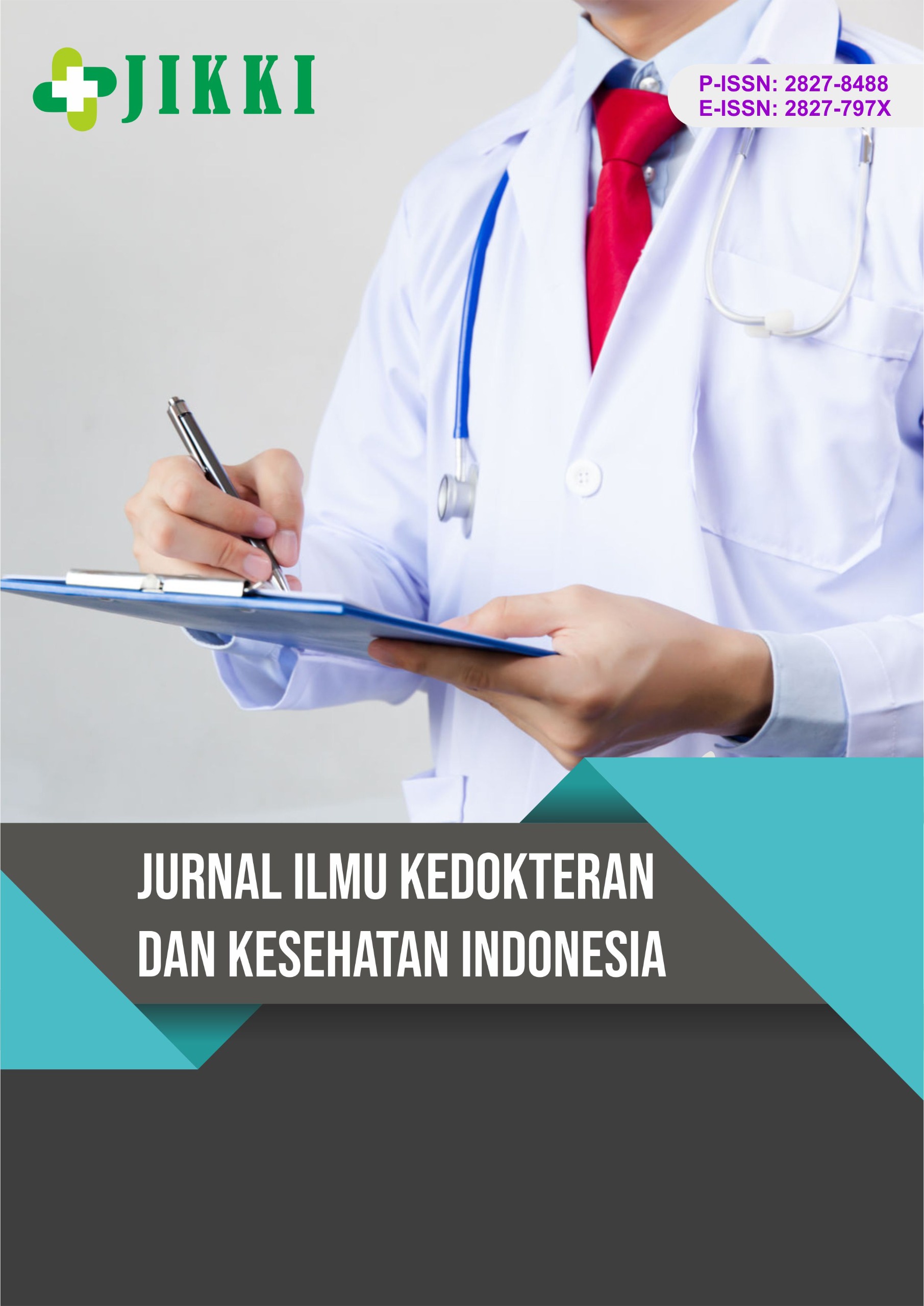Penentuan Nilai SPF (Sun Protection Factor) Limbah Destilasi Rimpang Jahe Emprit (Zingiber officinale Var Amarum) dengan Metode Spektrofotometri UV-VIS
DOI:
https://doi.org/10.55606/jikki.v5i3.8148Keywords:
Emprit ginger, Natural sunsreen, Phytochemical screening, Sun Protection Factor , UV-VIS spectrophotometryAbstract
Zingiber officinale Var. Amarum (commonly known as jahe emprit) is a local ginger variety recognized for its richness in bioactive compounds, including flavonoids, phenolics, tannins, saponins, and terpenoids, which are widely reported to possess antioxidant properties and the ability to absorb ultraviolet (UV) radiation. These characteristics highlight its potential as a natural source of photoprotective agents. The present study was conducted to evaluate the Sun Protection Factor (SPF) of ginger rhizome distillation waste and to perform phytochemical screening in order to identify its secondary metabolite content. Distillation was performed on 250 grams of fresh ginger rhizomes using a solvent ratio of 1:2 (b/v). The process yielded 130 mL of liquid waste with a 52% recovery rate and retained the distinctive aromatic profile of ginger. Phytochemical analysis revealed the presence of flavonoids, phenolics, saponins, and phytosterols, while alkaloids were detected only in trace amounts, suggesting the waste still contains valuable bioactive constituents despite undergoing distillation. Determination of SPF was carried out using the Mansur spectrophotometric method, which measures absorbance within the wavelength range of 290–320 nm at 5 nm intervals. The extract demonstrated an average SPF value of 39.29, which is categorized as ultra protection, indicating a very high level of photoprotective capacity. These results confirm that ginger rhizome distillation waste retains compounds with strong UV absorption and antioxidant potential, supporting its use as an active ingredient in sunscreen formulations. Beyond its functional efficacy, the utilization of this by-product also promotes sustainability by reducing waste from the essential oil industry and contributing to eco-friendly cosmetic innovation. In conclusion, the study provides scientific evidence that ginger distillation waste can be valorized into high-value products, offering both environmental and economic benefits while meeting the growing demand for natural and safe alternatives in skincare formulations.
References
Antari, E. D., Santika Putri, V., Winarni, A. A., Syahrul, M., Politeknik, A., & Surakarta, I. (2024). Potensi hidrosol sereh wangi sebagai SPF (Sun Protection Factor) dalam sediaan lotion mikroemulgel. Jurnal Ilmiah Ibnu Sina, 9(1), 160–169. https://doi.org/10.36387/jiis.v9i1.1718
Aris, M., & Adriana, A. N. I. (2022). Penentuan kadar total flavonoid dan nilai SPF (Sun Protection Factor) ekstrak etanol rimpang temu ireng (Curcuma aeruginosa Roxb.) secara spektrofotometri UV-Vis. Fito Medicine: Journal Pharmacy and Sciences, 12(2).
Badriyah, B., Achmadi, J., & Nuswantara, L. K. (2017). Kelarutan senyawa fenolik dan aktivitas antioksidan daun kelor (Moringa oleifera) di dalam rumen secara in vitro. Jurnal Peternakan Indonesia (Indonesian Journal of Animal Science), 19(3), 116. https://doi.org/10.25077/jpi.19.3.116-121.2017
Hardiyanti. (2015). Pemanfaatan aktivitas antioksidan ekstrak daun kelor (Moringa oleifera) dalam sediaan hand and body cream [Skripsi, Universitas Islam Syarif Hidayatullah].
Itamar, S., Utomo, T. P., Fadhallah, E. G., & Raysid, H. A. (2023). Formulasi minyak atsiri (essential oil) cengkeh (Oleum Syzygium aromaticum) pada pembuatan eau de perfume. Inovasi Pembangunan: Jurnal Kelitbangan, 11(2), 209–224. https://doi.org/10.35450/jip.v11i02.398
Julianawati, T., & Hendarto, W. H. (2020). Penetapan total flavonoid, aktivitas antioksidan, dan karakterisasi nanopartikel ekstrak etanol daun kelor (Moringa pterygosperma Gaertn.). Jurnal Penelitian Kesehatan Suara Forikes, 21(1), 1–9. https://doi.org/10.33846/sf11110
Mangunsong, S., Assiddiqy, R., Sari, E. P., Marpaung, P. N., & Sari, R. A. (2019). Determine of β-caroten in carrot (Daucus carota) using ultra-high performance liquid chromatograph (U-HPLC). Jurnal Sains dan Kesehatan, 4(4), 36–41.
Purwanto, D. S., Susanti, H., Sugihartini, N., Pasca, M., Ahmad Dahlan University, Faculty of Pharmacy. (2021). Pengaruh purifikasi terhadap kandungan zat aktif dan aktivitas antioksidan ekstrak etanol 50% daun kelor (Moringa oleifera L.). Jurnal Farmasi Indonesia, 18(2), 97–108.
Putri, W. S., Warditiani, N. K., & Larasanty, L. P. F. (2012). Skrining fitokimia ekstrak etil asetat kulit buah manggis (Garcinia mangostana L.). Jurusan Farmasi, Fakultas Matematika dan Ilmu Pengetahuan Alam, Universitas Udayana.
Rahmati, R. A., & Lestari, T. (2018). Penetapan kadar total flavonoid ekstrak etanol dan fraksi daun saliara (Lantana camara L.) dengan metode spektrofotometri. Departemen Farmakognosi Prodi S1 Farmasi, Sekolah Tinggi Ilmu Kesehatan Bakti Tunas Husada Tasikmalaya.
Saepudin, S., Hanifah, H. N., Hartono, K., Mutiara, L., & Andita, D. (2024). Profil kromatografi lapis tipis dan aktivitas tabir surya ekstrak etanol 70% daun kesum (Polygonum minus Huds). Jurnal Ilmiah Farmasi Farmasyifa, 7(2), 192–203. https://doi.org/10.29313/jiff.v7i2.3667
Selvina, F. (2016). Uji potensi tabir surya dan nilai Sun Protecting Factor (SPF) ekstrak etanol daun pedang-pedang (Sansevieria trifasciata Prain) secara in vitro [Skripsi].
Sugihartini, N., Sari, D. E. M., Bachri, M. S., & Yuliani, S. (2019). The amount of β-carotene, total phenolic, and total flavonoid of ethanol extract of Moringa oleifera leaves with variation concentration of solvent. Advances in Health Sciences Research, 18(ADICS-PHS 2019), 110–114. https://doi.org/10.2991/adics-phs-19.2019.22
Suhesti, I. (2019). Penentuan total fenol dan nilai Sun Protection Factor (SPF) ekstrak etanol biji kopi robusta (Coffea canephora Pierre ex A. Froehner). Jurnal Ilmiah Farmasi Farmasyifa, 2(2), 67–74.
Wulandari, R. (2016). The influence of various concentration of red roses (Rosa damascena Mill) flower extract to anthocyanin color stability jelly as biology learning source. Jurnal Pendidikan Biologi Indonesia, 2(1), 48–56. https://doi.org/10.22219/jpbi.v2i1.3371
Zulkarnain, H. H. S., & Kartika, A. (2013). Stabilitas fisik dan aktivitas krim W/O ekstrak etanolik buah mahkota dewa (Phaleria macrocarpa (Scheff.) Boerl) sebagai tabir surya. Traditional Medicine Journal, 18(2), 109–117.
Downloads
Published
How to Cite
Issue
Section
License
Copyright (c) 2025 Jurnal Ilmu Kedokteran dan Kesehatan Indonesia

This work is licensed under a Creative Commons Attribution-ShareAlike 4.0 International License.








